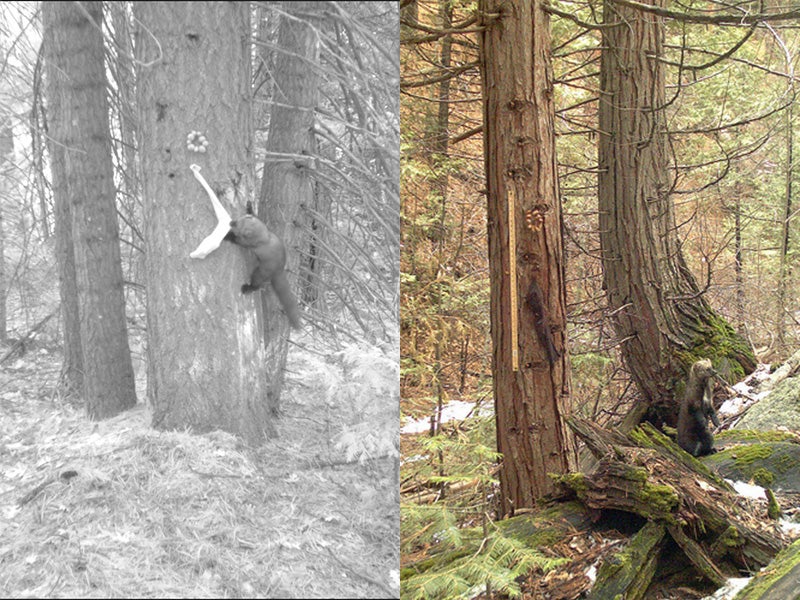Monday Reads: The Pacific Fisher & Socks Edition
Who is the Pacific fisher, and why did he want your socks?

This page was published 13 years ago. Find the latest on Earthjustice’s work.
Deep in California’s Sierra Nevada, a field biologist prepares a delicacy favored by one of the most elusive hunters of the forest.
The meal is known—literally—as “Chicken-in-a-Sock.”
The connoisseur is the imperiled Pacific fisher (Martes pennanti). The fur trade devastated the species (the fisher’s coat, no less splendid than that of his close relations, the wolverine and mink, was highly coveted), as did logging.
Denning in large trees and rocky crevices and hunting through a sprawling home range, this solitary carnivore depends on undisturbed landscapes of old growth forests.
Few still exist, and those that do are often fragmented by roads and other development.
In California, only two far-flung populations remain: one along the Oregon border and another in the southern Sierra Nevada. One is the subject of a multi-year study by UC Berkeley’s Sierra Nevada Adaptive Management Project, which is investigating the impact of vegetation management plans on the animal’s population in the area.
The study uses bait stations and motion-activated cameras to aid in gathering data. The key to convincing fishers to sit still long enough for a clear photo?
Socks. Delicious, meat-filled socks.
In order to get to the meaty core, fishers must first spend a bit of time gnawing their way through the sock, inadvertently pausing for the camera. Hundreds of socks were soon giving their lives to science (and great photos).
Team members raided their sock drawers. As supplies dwindled, they turned to big box stores, diverting valuable project funds.
And then, they thought about other people’s sock drawers.
Shortly before Christmas, a blog post appeared. Do you have socks of the single-variety, their mates long since abducted by UFOs or retired by hole-y disfigurements? Send them on down. Reduce, reuse, recycle: your socks will go to a good cause.
Socks arrived. Little ones children had outgrown. Sporty ones nonagenarians no longer played tennis in. Gaudy holiday ones re-gifted with relief. And, heartwarmingly, orphaned ones whose recently deceased owners had loved mountains.
Within a month, the team had enough socks for the remainder of the study. Socks unsuitable for fisher duty (ankle socks and sultry, sheer ones) were donated to shelters; prime specimens in surplus were bartered to other wildlife teams.
In a scientific sleight of hand, gifts of hosiery were turned into a wealth of research data on these critically important animals.
Like all predators, fishers play an integral role in the overall health of the ecosystem, including regulating the population of its prey species. Notably, fishers are the only animal known to regularly dine on porcupines.
They have long been the target of timber interests, who have had an eye on the remaining old growths fishers need to survive. (Ironically, the timber industry was for the fishers, before it was against them, as porcupines can seriously damage trees.)
Earthjustice has fought for the Pacific fisher for more than a decade, bringing litigation seeking endangered species protections, as well as restoring safeguards stripped by the revised Sierra Nevada Framework management plan.
A court ruling in 2012 ordered the California Fish and Game Commission to reconsider its decision to deny state Endangered Species Act protection to the fisher. It is a significant step forward in the long battle for the fisher’s future.
At the time, Earthjustice attorney Erin Tobin noted, “There are probably fewer than 150 adult female fishers left in the entire Sierra Nevada. If ever there were an animal that desperately needs protection, this is it.”
In the meantime, their need for socks, at least, has been happily more than met.
Bonus photos: The “Chicken-in-a-Sock” delicacy attracted more than the fishers. Take a look at a few other visitors who stopped by to investigate (or to taste), unknowingly posing for the remote camera:
The California Regional Office fights for the rights of all to a healthy environment regardless of where in the state they live; we fight to protect the magnificent natural spaces and wildlife found in California; and we fight to transition California to a zero-emissions future where cars, trucks, buildings, and power plants run on clean energy, not fossil fuels.